The Meizu PRO 5 Review
by Matt Humrick on June 24, 2016 8:00 AM EST- Posted in
- Smartphones
- Exynos
- Mobile
- Meizu
- Exynos 7420
GPU Performance
Meizu’s PRO 5 uses a Mali-T760MP8 GPU with a maximum frequency of 772MHz for ALU-heavy workloads. Based on ARM’s Midgard architecture, the Mali-T760 is capable of outperforming Qualcomm’s previous generation Adreno 400 series GPUs at vertex processing, but falls behind in pixel processing.

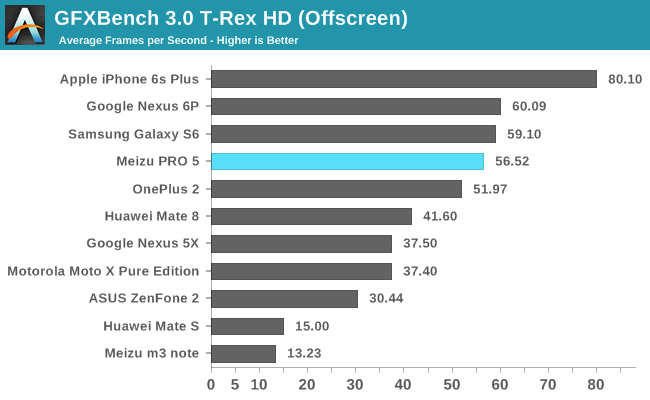
To better understand how the PRO 5 performs across a wide variety of games, we will start by looking at the OpenGL ES 2.0-based T-Rex game simulation. Because of its 1080p display, it has fewer pixels to process than the 1440p Galaxy S6, leading to better onscreen performance. Peak offscreen performance is also good, comparable to the Nexus 6P and its Adreno 430 GPU.
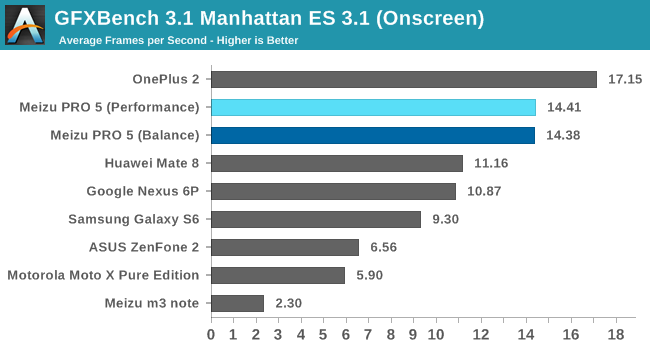
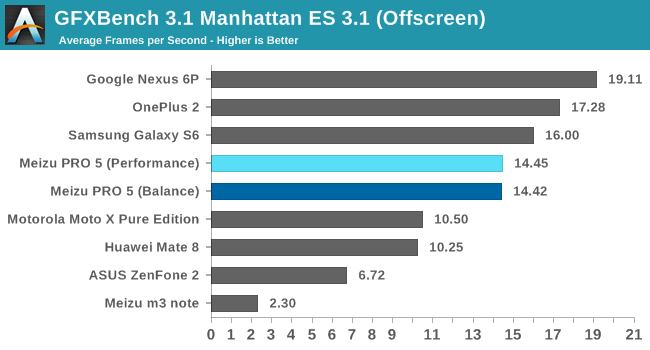
The GFXBench 4.0 Car Chase game simulation, which uses OpenGL ES 3.1 plus Android Extension Pack (AEP) features, is part of our normal test suite; however, the PRO 5 does not support hardware tessellation and is not able to run this test, so instead we’ll fall back to using GFXBench Manhattan 3.1, which still uses OpenGL ES 3.1 but does not use any AEP features.
Starting off, the PRO 5’s results are the same for both the Performance and Balance power modes. While the different modes will have some effect on performance for games that are more CPU bound, this test is entirely GPU limited, and because the PRO 5’s power modes do not affect GPU frequency, they have no impact in this test.
In the offscreen test, the PRO 5 is about 38% faster than the Moto X Pure Edition (Adreno 418) and the Mate 8, which uses the newer Mali-T880 GPU. While the Mali-T880 includes three ALU units per core versus two ALUs per core for the Mali-T760, the Mate 8 uses only four cores where the PRO 5 uses eight. After accounting for the difference in GPU clock frequency, this gives the PRO 5 124 GFLOPS of FP32 throughput versus 108 GFLOPS for the Mate 8. And because the PRO 5 has twice as many cores as the Mate 8, it can process twice as many texels/pixels per cycle too. This also applies to Huawei’s P9, whose Kirin 955 SoC uses the same Mali-T880MP4 GPU.
In the older GFXBench T-Rex test, the PRO 5’s performance was similar to the OnePlus 2 and Nexus 6P, which both use Qualcomm’s previous generation Adreno 430 GPU. This test, however, includes many more pixel effects, which take advantage of Adreno’s superior ALU performance, giving the Nexus 6P a 32% advantage over the PRO 5. While not shown in the charts above, phones such as the LG G5, which use the latest Snapdragon 820 SoC and its Adreno 530 GPU, are about twice as fast as the PRO 5 in this test.
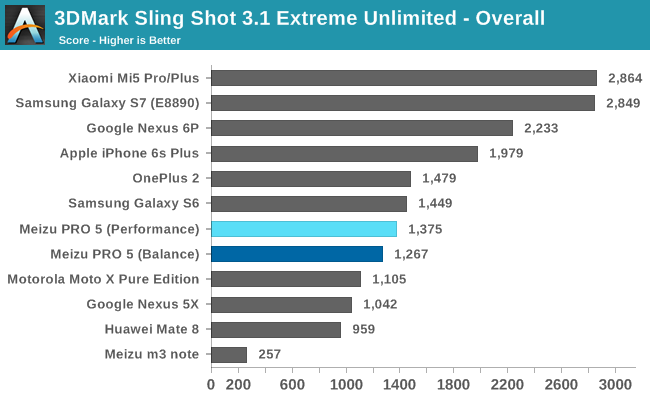
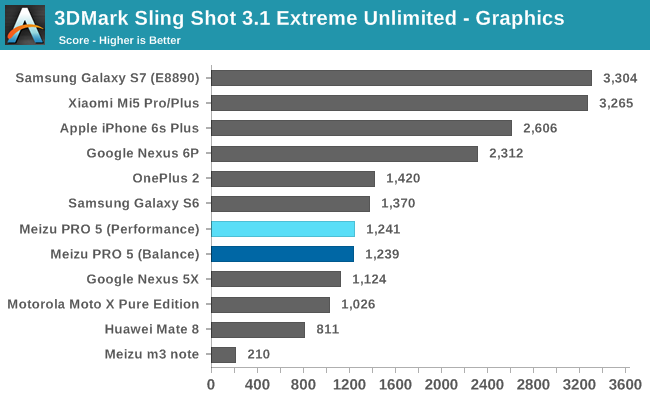
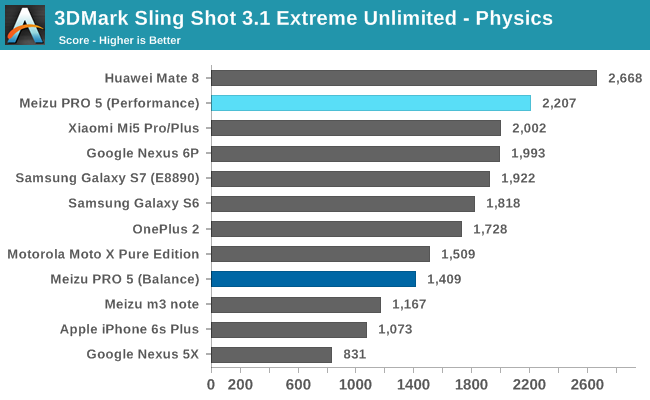
3DMark Sling Shot Extreme is another OpenGL ES 3.1 game simulation test that renders offscreen at a higher 1440p resolution than our other tests (the Physics test renders at 720p) and includes both GPU and CPU elements. Zeroing in on the graphics score, we see the PRO 5 outperform the phones using Adreno 418 and Mali-T880MP4 GPUs once again. The Nexus 6P and its Adreno 430 is 86% faster, however. The Xiaomi Mi5 (Adreno 530) and Galaxy S7 (Mali-T880MP12) perform about the same in this test with peak performance 2.66x higher than the PRO 5.
The Physics test measures CPU and memory performance by running an open source physics simulator. The PRO 5 and its Exynos 7420 SoC perform quite well, outperforming the newer Exynos 8890 and Snapdragon 820 SoCs in the Galaxy S7 and Xiaomi Mi5, respectively. Only the Mate 8’s Kirin 950 performs better. Because this is primarily a CPU test, we see a significant difference in performance between the PRO 5’s Performance and Balance modes, with the former showing a 57% advantage.
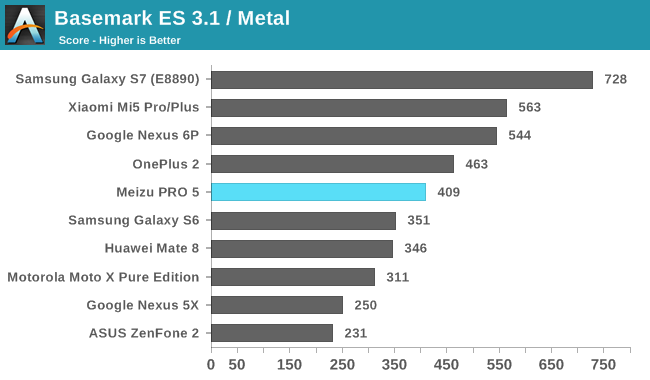
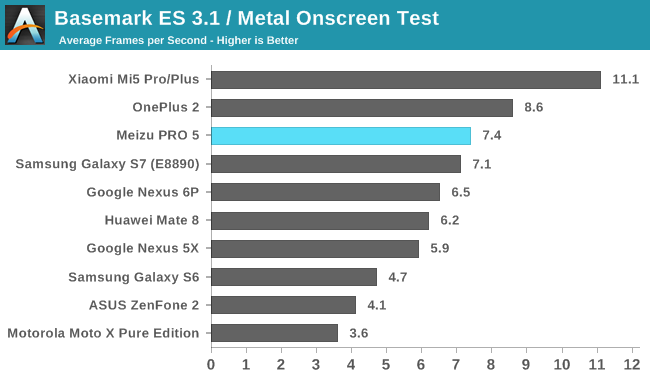
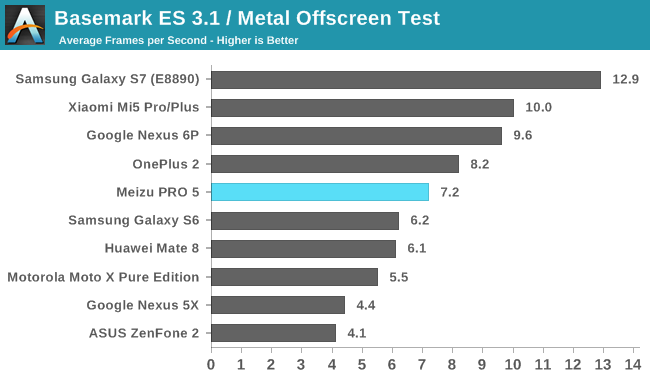
The previous performance trends hold true in Basemark ES 3.1. The Galaxy S7 at the top of the offscreen chart uses a Mali-T880MP12 GPU running at up to 650MHz. This gives it a peak, theoretical FP32 throughput of 234 GFLOPS, more than twice the Mate 8’s 108 GFLOPS and about 1.9x the PRO 5’s 124 GFLOPS, which is very close to the overall performance difference between the PRO 5 and Galaxy S7 (Exynos 8890).
The Meizu PRO 5 is certainly capable of playing modern games as long as they do not require hardware tessellation—its graphics driver currently does not support this feature. It cannot match the peak performance of the latest SoCs, but that level of performance is still overkill for the majority of games currently available. Its 1080p display, which is a negative mark overall, at least helps improve onscreen graphics performance.










80 Comments
View All Comments
theduckofdeath - Sunday, June 26, 2016 - link
The audio part looks really, really interesting. Too bad the rest of the phone doesn't get the same level of attention to detail.andychow - Sunday, June 26, 2016 - link
Most of these Chinese phones are excellent, but you have to look at the LTE bands. Many are not compatible with North American LTE. From what I can directly check, this phone is NOT compatible with north american LTE network.sonicmerlin - Sunday, June 26, 2016 - link
Honestly who cares about all these phones? None of them will get updated past one update at most. And they still lag and have garbage collection hiccups while scrolling. Android is such a pain in the neck OS.theduckofdeath - Monday, June 27, 2016 - link
Almost 90% of all smartphone buyers cares, I think? You know, the ones who buys them instead of clinging on to irrelevant one-liners from 2008. :Dhalcyon - Monday, June 27, 2016 - link
Thank you for your excellent reviews. Yes, they are selective and sporadic, but hey - better these than nothing.If I may suggest something:
- consider having the same phones in each comparison chart (having model A appear in performance and missing in battery life does not make for easy comparison)
- This year and next year will be the year of the chinese mega-phones: LeEco, Oppo, Vivo, Meizu, etc.
You will get c. all the performance and very modifiable ROMs for c. 50% of the price compared to Apple, Samsung, LG, etc.
Review more of those and you'll get plenty of interested viewers/readers/ad impressions.
fanofanand - Monday, June 27, 2016 - link
Nice phone, terrible price. With the days of carrier subsidies behind us, fewer and fewer people will fork out $500+ for a phone (see iPhone SE). The idea that they will choose, at this price range, to go with a company that doesn't provide security or OS updates means only a fool would choose this over the many excellent options out there. I like the nand, I like the CPU, but at that price, I don't see how they will sell well globally.DocRambone - Monday, June 27, 2016 - link
Hoho, Anand?, how about the Mi5 review?Kkikdjjdw - Wednesday, June 29, 2016 - link
https://logicielespiongratuitblog.wordpress.com/20...Dans un rapport, un père assistait à une réunion sur le suicide chez les adolescents aux États-Unis a vu l'un des autres parents pop up comme un ami potentiel le lendemain.
qwert - Friday, July 1, 2016 - link
Not worthy, though.darkvader75 - Monday, July 4, 2016 - link
Great review on a under reported market. Most likely due to how many models can't be sold outside of China due to copyright issues when not in their home market.